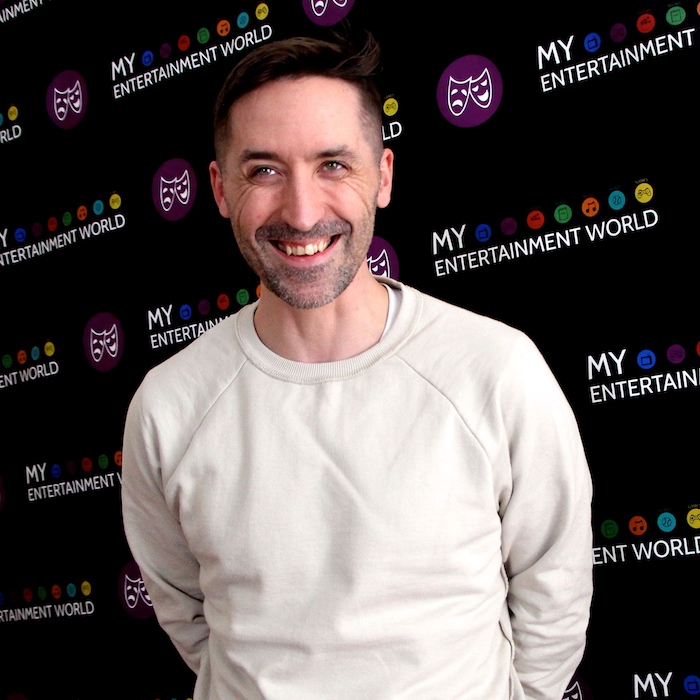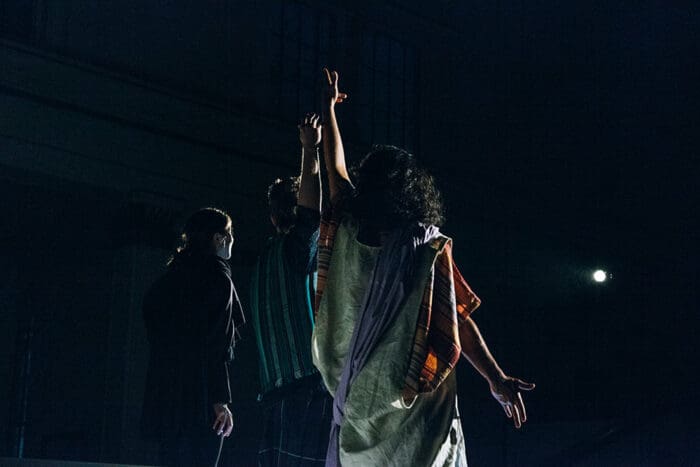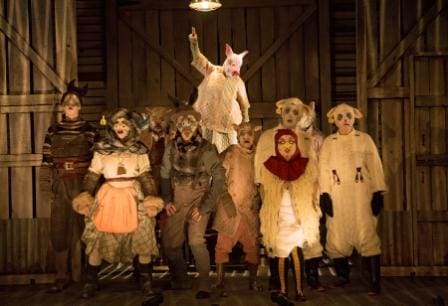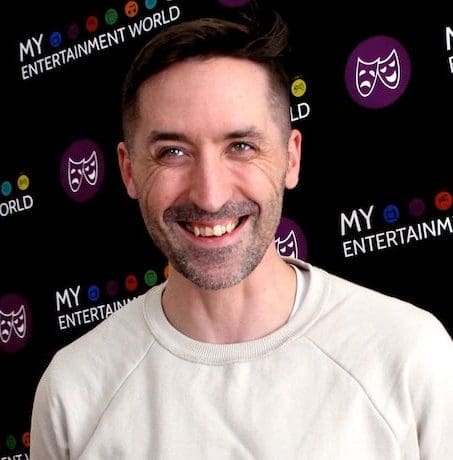 Before we announce the winners of the 2017 MyEntWorld Critics’ Pick Awards, we’re proud to present our annual Nominee Interview Series.
Before we announce the winners of the 2017 MyEntWorld Critics’ Pick Awards, we’re proud to present our annual Nominee Interview Series.
A Soulpepper Academy alumnus and Resident Artist, Ken MacKenzie has designed some of the most beloved productions in recent Canadian theatre history- Kim’s Convenience, Alligator Pie (which he also co-created), and you should see his latest- Animal Farm, on stage through April 7th. He won Outstanding Set & Costume Design in 2015 for his immensely creative work on Mr. Burns, a Post-Electric Play and is nominated again this year but this time for his Outstanding Lighting work on Public Records’ Other Jesus, an inventive site-specific piece staged in a church during sunset.
Do you remember your first experience with theatre?
Oh, it goes way back. I was in an arts school. I was one of those kids, starting in Grade 4. I went to an arts school – I changed schools, and I’d actually gone there for art. I’d done a lot of drawing, and I guess other teachers, and certainly my parents noticed it. So I tried out for the Claude Watson School, which is in North York, and I got in for art, but then I really took to drama. So I ended up doing drama in all of its forms for a really long time, and I was an actor.
I’ve got an undergraduate degree in acting, and then became a designer. That means my first experience was 8 or 9, or however old you are in Grade 4, when I really started to figure out what drama and what theatre was. It became such an integral part of learning for me that it’s tough to separate it – I think of theatre as such a pedagogical thing that it’s like, “I went to school, and I learned through drama.”
How did you make that transition back into the visual side of things, from being a performer?
I became a pet project of the Head of Design at Concordia University. I took some of her elective classes in my last year. Just as I was on my way out the door, I decided, “Oh, I have all these elective spaces. Why don’t I take some design? I’ve taken art classes while I’ve been here, but I’m gonna take some design classes.” And she decided, “Oh, you should be a designer.” So she made me her assistant for a little while, and that just kind of snowballed into me working as a designer, and eventually deciding, “I actually prefer this to acting, so why don’t I just keep doing this? More fun. More interesting.”
Why is it more fun?
The real truth is, I think I decided [that] when I was auditioning after I’d graduated. I was living in Montreal, auditioning for film and television parts, and some theatre parts, and I had to audition for a character in a coma. [laughs] I decided at that point it’s just not worth it. It’s not fun to audition for people in a coma, and that sort of thing. So I just decided it feels like you’re a little more in charge of your life if you’re designing. People who act, I have a huge amount of admiration for the kind of patience it takes, and I just felt like I didn’t have that kind of patience.
What was the first show you ever designed?
The first show that I ever full-fledged designed? There was a Fringe show- which you can hardly call full-fledged designing, because you can put it up in 15 minutes- that was called Famous Lies, which my good friend Aaron Abrams wrote, and he’s a great writer. He’s on a bunch of television shows now, you might recognize him if you saw his face. So we did that show together. It was fun, but it was Fringe. Up and down, really quick.
Your nomination this year is for Lighting Design, but you’ve actually won before for Set Design. How do those two practices complement each other?
I think of them a little bit like time and space. That’s the short version of how I personally think about it. Space, of course, is set design, and often it’s a little bit more static. It’s usually a lot more static, but what you articulate through set is the foundation for any play, and I think of lighting as the music. It’s temporal. It moves with the arc of the show. Sometimes the set does that as well, but usually the set is the core, I guess, and the light is the melody of the whole thing.
Lighting design is something that not a lot of people know a lot about. What would you say is the most integral part of it that people maybe overlook?
It’s so funny. My mother, whenever she comes to see a show – or at least the first time I ever did lighting design, she was like, “I didn’t really notice the lights”. I guess that’s a part of it, right? People who don’t know lighting just don’t really notice it’s there. I think it often comes in in a subconscious way, and affects people in a subconscious way. And I think it’s a good thing. If people don’t really notice it. sometimes you want them to see it. you want it to draw a little more attention, but I think it does hit on a primal level, like what you see, the way that you take in that information, is so primal.
What should people know about it? It’s really important story-telling. I know a lot of directors who really feel like they need to work very closely with the lighting designer because it has that much power over the way a story is told, and I agree with that. I think a lighting designer needs to be very sensitive to everything that a director is hoping to do, and what the actors are trying to do, too. And the writer. Everybody. If the lighting design isn’t at the fulcrum of where all those people are trying to go, it could be a disaster.
 Other Jesus was in a very unconventional space and told a story where lighting had a big impact. How did you approach the design with those things in mind?
Other Jesus was in a very unconventional space and told a story where lighting had a big impact. How did you approach the design with those things in mind?
One of the first things that we thought about, because of the unconventional space, is that we really looked at liturgical lighting, because it was in a church. Lighting has so much meaning in faith, and in religion. In almost every religion, there’s an idea of light that is divine in some way. It means a lot. That was the first thing I thought about.
Because we knew at the time of year that we were gonna be doing the show, it was almost like doing outdoor theatre. We knew that it wasn’t actually gonna be dark for the first portion of the show, but we were really excited by the idea that the sun would set during the course of the show, and slowly we would gain control. But there would be natural lighting, and that seemed appropriate for Other Jesus – that we would go from natural lighting to something unnatural that we would be able to really force in strange ways.
What were some of the interesting conversations you had with the director in terms of shaping the lighting design, going off of those ideas?
I think the biggest thing that was immediate from the get-go is that Frank Cox-O’Connell, who was the director, Evan Webber [the playwright], and Ame Henderson, who was a collaborator on the show- when they approached me about it, they also wanted me to be in it. So that was gonna be a part of the deal. “We want you to design this, and more or less to run it, but we also want you to be in it.”
That presented some limitations about how we thought about it – like there couldn’t be somebody at the board always ready to press buttons. So it needed to be thought of in arcs, in these big sweeping gestures that might take a few minutes, so I could press a go button, go be onstage for a little while, and then come back to the board, and not worry about missing a cue.
There were a couple of times where I had to say to somebody else who was in the show, “Okay, [for] this moment, I’m gonna need you to press a button.” I’d put tape on the lighting boards saying “This button. Not this button. Don’t touch this one, touch this one.” So that in and of itself was unusual – certainly, I’ve never been in a show and also run the lighting board. That’s a thing I’ve never done.
It all seemed so fluid, though. I think Ame, Evan and Frank knew what they were asking for, and they wanted to create a really collaborative sense amongst all of the creators in the show. It wasn’t just me. The set designer was in the show, and the sound designer was in the show – everybody who participated also appeared in the show, and that made for a really unique, communal feeling amongst the cast and crew. Everybody was cast, and everybody was crew.
What were some of the technical challenges of doing something so low-budget, and in a space that doesn’t have things like a grid?
That definitely weighed into how we thought about the space, too. We had to think about how much electricity we could bring into the room, because there were only like five plugs in the wall, and we knew we needed more power than that. There were a lot of those really technical things where we had to rent dimmer packs, and tie in directly to their power in the basement.
John Thomson, the technical director at Tarragon, was the one who came in and did all the electrical work for us. Sandra Henderson, who was the production manager, figured out all the logistics of running all the cable that we were gonna need. I think we looked into the idea, or talked about maybe hanging something from the ceiling, but we were warned against that. That maybe the place was not in that good condition. So we just worked with the limitations that were in the space, but I think that that’s what brought us to a really nice final product – they didn’t feel like limitations, they felt like guides to us. “Okay, well, this is the path we’ll follow.” I think the whole show really had that feel – we’re not running into obstacles, we’re moving around things, and developing in that manner.
The lighting design contributed to quite a few singular images that really stood out. Did you have a favourite in that production?
I had a lot of fun working with this one single strip, way downstage. It was such an odd set, because it was on top of all the pews. So I had a lot of fun – there was just this single strip of LED that acted as a footlight, and as the show went on, that became more prominent.
There were a couple of images there that I thought were really nice. There’s one moment in particular that I always really liked, and it was when Ishan [Davé] was in a transition moment. We had a fresnel sitting on the ground in one of the pews, and so he went to the end of the stage and leaned over, and a light came on from beneath the pews and shot right up at him. It’s a bit of a surprise for people in the audience, because they wouldn’t have expected a light to be on the ground in that moment.
That was maybe one of my favourite moments. I think it was a really beautiful singular moment, but there’s also this moment on a ladder, way, way at the back of the space. We just managed to hit one of the actors with a nice little light, and it created this beautiful shadow on the massive wall in the back. It was just a fun space to play in, and be surprised by. I think we were able to translate some of those spatial, surprising moments, using the lights. Things that we discovered, we got to share with the audience.
What would you say is your top priority as a designer?
You know, it sounds a little selfish, but I always want to surprise myself a little bit, or entertain myself with what I’m doing, and not feel like “Oh, this is something I’ve done before. This is something I’m really keen on doing.” And hopefully that also works well for the show, and for the director, that it’s not something I’m just entertaining myself. But I think that that’s an important thing for any artist, to feel like they’re engaged in their own work, and that they’re not servicing something in a really boring way.
What’s the most important thing? I really like collaborating. Working really closely with the director is the thing that feels like it’s the most important. Most of the really interesting discussion and the really interesting ideas come out of those conversations. So I would say that if it looked like I’m not doing that, that’s when I’m feeling like, “What am I doing on this show? What’s happening here?” I start to get a little antsy and anxious. If it’s just me entertaining myself, then it feels like I don’t really feel rock solid in what I’m doing. So I think good collaborators is the thing that I’m always looking for.
Were you pleased with how the design worked in practice, and did you have any big ideas that you weren’t able to do for practical reasons?
Yeah, it’s funny. If it were in a theatre, it would have been a totally different show.
I wouldn’t even have considered some of the things that we did, but it felt like we were so guided by the fact that there was so much natural light, that we couldn’t hang lights anywhere, that we only had a few positions. We only had so much power. Like I said before, it didn’t feel like limitations, but we were bound by those things. So it’s not something I ever would have done. If I had had a hundred lights, and endless power, I never would have dreamed of doing a design like that. So I’m grateful to be put in that situation, where you have to just think of something really unconventional.
I guess it’s a bit of a lesson to try and remember that when you’re in a theatre, there are all these rules to designing that we take for granted. There’s no reason why you couldn’t break those rules, but because you’ve got a grid, of course we’re going to hang lights from a grid, and we’ll have footlight positions, and we’ll have booms. But actually, when you think about it, that’s really quite limiting. You could do anything. So I guess it’s good to be reminded of that.
It’s good to do projects like Other Jesus. Just as an artist, in my own development, it’s good to remember that we assume a lot of rules when we’re working on theatre. We should shake those off every now and again. Not feel so tied up.
 You just opened Animal Farm with Soulpepper, where your costumes are real showstoppers. Tell us a little bit about that piece, and some elements of the design that you’re particularly proud of.
You just opened Animal Farm with Soulpepper, where your costumes are real showstoppers. Tell us a little bit about that piece, and some elements of the design that you’re particularly proud of.
I was really, really lucky. That show’s been workshopped maybe once a year – not often, but it’s been in workshop status for almost five or six years now. Ravi Jain [director] first proposed it five or six years ago, and he got me on board, and so we had done a couple of workshops over the years.
Maybe [once] a year, we would sit down for three or four days, and either work on the script, or work on design ideas. So I’ve had the chance over all that time to consider what it would mean to turn actors into animals, and how to figure out some of those Animal Farm rules, like “four legs good, two legs bad”. Does that mean that we want to put people on all fours for the whole show, or would that just be the worst thing to watch? In the end, we decided, first of all, actors would hate it. They would think it was the worst idea in the world. And I don’t think audiences would like it that much either, because it would inhibit the actors so much. So what it came down to was ultimately, Animal Farm is an allegory about people, so let’s just let them be people.
But we’d had so much opportunity to figure out what worked for pigs, when we were just pulling things from the Soulpepper wardrobe, and some of those workshops, and trying things on and figuring out worked best. All the sheep were were two sweaters: one pulled over legs, and one pulled over their head with some suspenders, and we figured that out two years ago. That’s a great way to do it. It’s really easy to do sheep. And you can’t really make them a better costume than that. It’s dumb, but it’s really great.
I had the benefit of having input from [what feels like] half the actors in the city who at one point or another helped us workshop the show. I just gathered a lot of people’s creativity and applied a little bit of my own, and came up with all these costumes. It didn’t feel that challenging, because it felt like it was so much fun. It felt like it was just an opportunity to be stupid, and excel at being stupid – the more dumb you could be, the better. It definitely got one foot solidly in clown, I think. At least in the development of the costumes, it was placed there. So it was great.
I think Rick Roberts was amazing as Napoleon [the pig]. And the way that he embodied that animal was great. On the second or third day of rehearsal, he brought in his own nose. He was in his basement, and he made a nose out of latex. And it looked hideous, especially compared to all the other pigs’ noses, which we’d found at Malabars, or some other costume shop. But they were really effective. They looked good, so we kept them. Then he brought in his own nose, and it was weird and lumpy in a strange way, but it actually looked perfect at the same time. it was really gross, but it was really perfect. And so he brought that kind of enthusiasm – and I think all the actors did, to a certain extent.
People were really enjoying their fittings, and Erika Connor, who is the assistant wardrobe head at Soulpepper, was really excited to be working on it too, so she was throwing in ideas. It feels like I was at the centre of a storm of a lot of people getting really excited about doing these costumes, and I could just collect a bunch of ideas from all the people who were keen to do it.
What’s your favourite design you’ve ever worked on?
That’s really hard. I don’t know! It feels like you just swing from vine to vine on designs. I’m usually pretty happy – [though] every once in a while I feel like I don’t get it. I feel like it was a swing I’ve missed. That happens a little bit less and less these days. I think I’m getting better as a designer.
I had a really good time on these Animal Farm costumes, and I don’t always get to do costumes. It’s not a thing that I do as often as other things, and I feel that it’s the thing that I’ve studied the least. So it feels like a brave new world for me whenever I do costumes. I’m like, “Oh, this is gonna be fun. I barely ever get to do this.” So there’s a bit of excitement for me when I get to do that.
What else, though? That’s really hard! I think I like a lot of them for different reasons. Kim’s Convenience was fun because it was such a specific thing to do, and that show did so well, and I was really happy to be involved in it. But it was a totally different thing than Spoon River, for instance, which I also really liked. I don’t know if I can answer that, my favourite design. It’d be way easier for me to answer which were my least favourites.
What’s your next project?
Rehearsals started this week for La Bête at Soulpepper. Next week rehearsals start for Ma Rainey’s Black Bottom. I’m working both of those. After that, Dream in High Park shows. I’m working on both of those. That’ll be fun.
I’ve got a really busy slate this coming year. Part of it is because things were so crazy at Soulpepper in January. I had a bit of a moment of panic where I was like, “I’ll take everything. I’ll take it all. I don’t know what’s gonna happen.” I felt so uncertain. I was like, “Yes, yes! Yes. I’ll take that job.”
So now you have too many jobs?
It’s all manageable. I haven’t overbooked myself to the point of not being able to be in three places at once. I don’t have to do that. But I’ve got a pretty full slate in the next little while.
Do you have anything you’d like to add?
Other Jesus was a real treat. It was such a different method of development. That has everything to do with Frank, and with Ame, and the way that they create theatre. Evan Webber as well, whose commitment to aesthetic integrity is pretty amazing. He set the tone for the whole experiment that that show was. I think that’s such a positive thing, the way that their brains work. I’m working on different kinds of projects, projects that are happy to throw everything aside and really have their own style, which is, I think, what Other Jesus was – a real treat.

